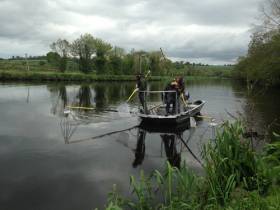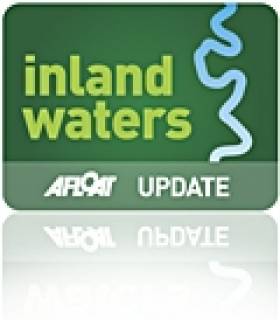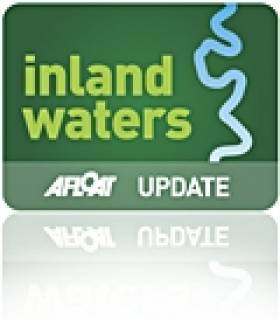Displaying items by tag: river barrow
Crayfish Plague Spreads To River Barrow
#Crayfish - Large numbers of dead freshwater crayfish have been reported in the River Barrow in the stretch from Carlow to Graiguemanagh.
It has been confirmed using DNA analysis that the cause of death was crayfish plague.
This is the fifth outbreak of the disease to be found in Ireland in the last two years, and follows just weeks after an outbreak in North Tipperary.
It is feared that if the disease spreads further, then it will threaten the survival of the entire Irish population of white-clawed crayfish, an endangered marine species.
This worrying situation is being investigated by the National Parks and Wildlife Service of the Department of Culture, Heritage and the Gaeltacht, Inland Fisheries Ireland and the Marine Institute.
All the agencies involved in managing and protecting the rivers in Ireland are concerned that another outbreak has been detected, and are reiterating their advice and guidance to all users of the river to implement routine cleaning and drying of their equipment once they leave the river and before using it again.
This is especially important as it is known that the crayfish plague organism can be carried on wet equipment to new sites. Containment of the outbreak is essential to prevent spread to other as yet unaffected populations in Ireland.
Waterways Ireland, which manages the Barrow navigation, has issued a marine notice calling all recreational, commercial, private and public body water users (boaters, walkers, swimmers, kayakers, rowers, machine operators, etc) to operate a temporary ban on moving watersport and angling equipment and other equipment or machinery that comes in contact with the water, out of or into the Barrow and all affected catchments.
People are also asked to alert the authorities of any mass mortality of crayfish or sightings of unusual crayfish that might be non-native species (such as crayfish with red claws, or of an unusually large size).
#NewService - An established Wexford boat tour operator writes Independent.ie is due to start a new river cruise service by bringing people on the Barrow by 2019.
New Ross Municipal District Director Eamonn Hore told last week's meeting of the body at Tintern Abbey that Kilmore Quay man Declan Bates has been planning the business venture - which will see up to 13 people employed - since 2013.
The vessel will be able to take between 90 and 150 people and would employ nine onboard staff on year one, running from mid-March to mid-October.
Describing the proposal as 'really exciting,' Mr Hore said the River Barrow is under utilised.
'There is a whole story to be told about the River Barrow. We want this to be a large scale, flagship experience linking Waterford and New Ross,' Mr Hore said.
The vessel is expected to cost around €1m and would run from opposite the Granville Hotel in Waterford city centre, to New Ross quay and back daily from March to October.
For more on this new venture, click here.
#Angling - New research from Inland Fisheries Ireland (IFI) has revealed the state of fish stock levels and the different species present within the River Barrow catchment.
The River Barrow is Ireland’s second longest river after the River Shannon, and this research is the first large scale catchment-wide survey undertaken in the popular angling waterway to assess the status of all fish species present.
The IFI report reveals that 39% of water sites surveyed on the catchment had high or good fish status.
The ecological fish classification status of various sites was calculated as part of the survey to assist with future fisheries management plans. This included assessment of 35 of the River Barrow’s main channel sites and a further 83 sites within the river’s sub catchments.
Overall, ‘High’ fish status was recorded on five per cent of sites, and ‘Good’ status was assigned to 34% of sites.
The positive fish status was recorded in the upper reaches of the River Barrow main channel above Mountmellick, Co Laois, downstream of weirs where flow and habitat conditions were more favourable for a larger range of fish species, and generally in the middle and lower sub-catchment river systems.
However, more than 60% of the sites were cited as moderate fish status or less.
The main reasons for less than good fish status were poor water quality, poor habitat, the presence of artificial barriers impeding migratory fish passage and possible competition from the invasive dace species.
Further investigation of these sites will be required prior to the implementation of mitigation measures such as improvements to water quality, habitat enhancement works to improve spawning and nursery areas or tree planting to provide cover for fish.
In addition to classifying the fish status of the sites, the species of fish present were audited as part of the research.
More than 10,000 fish were caught and released as part of the survey with a total of 14 fish species and one hybrid (mix) species identified.
Dace, an invasive fish species, was the commonest species in the main channel sites, followed by roach, perch and juvenile salmon, while salmon and brown trout were the commonest species in the sub-catchment rivers.
Pike were found in 54% of the main channel sites surveyed and brown trout were recorded at 45% of these sites.
Other fish species logged included minnow, gudgeon, eel, stone loach, three-spined stickleback and flounder, as well as roach-bream hybrids.
“This survey is the first of its kind within this large catchment area and it tells us a great deal about what is happening on these sites,” said IFI senior research officer Dr Fiona Kelly.
"It is evident that we have an abundance of different types of wild fish species present; however we also know that there are challenges for the catchment in terms of water quality, habitat and invasive species which will need to be addressed. Ultimately, this research will inform future fisheries management and protection strategies.”
IFI says it encourages all stakeholders on the River Barrow to support the conservation and protection of the river, its tributaries and the species contained within it.
It also hopes that community groups will consider what they can do to improve its water quality and ecology and create a healthy water environment for the benefit of all users.
Boating Traffic on the Grand & Royal Canals & River Barrow to be Impacted By Bye–Laws – IWAI
Carmel Meegan, President of the Inland Waterways Association of Ireland (IWAI) welcomed delegates to the IWAI National Council meeting in Tullamore on 8th confirmed that the proposed bye-laws do not put user requirements, local communities or tourism at the centre of the regulations. Delegates heard –
In general –
there are reports that boats present this time last year have now left the Canals – the IWAI says this is indicative of boaters' fears and a further future drop in navigation use
Waterways Ireland have suggested that the 1800 plus submissions delivered by IWAI - during the brief consultation period of only 21 days- are letters in support of the IWAI
Submission rather than viewing these as other individual submissions recognising the effort and concern held by wider communities
Waterways Ireland imposed restrictions never previously invoked on boats travelling by Canal to the Dublin Rally in 2014 – which is celebrating 40 years of community activity
the proposed toll €75 to travel between the Grand and Royal Canals is detrimental – the IWAI advises this is the now most expensive boat crossing in Europe
the Newcomen lifting bridge will open only 8 times this year, only 96 boats are permitted to undertake the Green & Silver route around the Grand and Royal Canals this season due to restrictions of use of the Newcomen lifting bridge, significantly curtailing the emerging 'Green & Silver' route – the IWAI advises this is a major miss for domestic and international boat tourism.
Concerns aired as to the Canals and Barrow as a tourism resource have included questions in the Seanad and the Dail; County Council input; national and local press articles; television and radio interviews; community websites; blogs and Facebook pages reflecting overall national concern.
Politically, this has grown to be a very big issue and is featuring highly as politicians face into local elections this summer. The IWAI have gained the interest of local, regional and national
politicians on this matter to date, and will present our position to the Oireachtas Joint Committee on the Environment, Culture and the Gaeltacht in Leinster House on 25th
The boating community is not averse to appropriate management, facility provision, and access to waterways. But boats are key attractions, as the lifeblood of the navigations, and need to be welcomed.
River Barrow Features in New Series of 'Abhainn'
#OnTheTV - A new series of Abhainn begins this evening on RTÉ One as the Irish-language TV programme explores Ireland's second-longest river, the River Barrow.
Described by the Kilkenny People as one of Ireland's most picturesque rivers, the programme will follow the near 200km journey from Glenbarrow Waterfall in Laois and along the Kilkenny-Carlow border - stopping along the way at such spots as Cushendale Woolen Mills - till it joins with the Nore at New Ross.
Future editions of the series will focus on the Blackwater and the Erne, taking viewers on a visually stunning journey revealing the unique personality of each river and the stories both ancient and new that tell us who we really are.
The new series of Abhainn begins on RTÉ One tonight Monday 28 January at 7.30pm.
Trial Dredging to Help Rid Barrow of Invasive Asian Clam
#INLAND WATERWAYS - Trial dredging operations to curtail the spread of Asian clams at designated sites in the lower River Barrow are set to conclude today.
Inland Fisheries Ireland (IFI) employed the use of a a traditional cockle harvesting boat to physically remove the clams from the river bed, in an effort to explore methods of controlling or eradicating what it describes as an "ecosystem-changing invader" in other infested waters.
IFI scientists supervised the trials, using teams of divers to quantify the result of the dredging efforts.
The Asian clam (Corbicula fluminea) is "a most unwelcome addition to the fauna of the lower River Barrow". The bivalve mollusc is regarded as "one of the most notorious aquatic invasive species in the world".
First recorded in the river downstream of St Mullin’s in April 2010, subsequent IFI studies have revealed that the Asian clam is firmly established in the lower Barrow and in the River Nore downstream of Inistioge. Populations have also been recorded in the River Shannon and in Lough Derg.
In one section of the River Barrow the clam has achieved a "staggering" density of almost 10,000 per square metre.
Dr Joe Caffrey, senior scientist with IFI, said of the trial dregding: “It is imperative that every effort is made to control the expansion and spread of this highly adept invasive species.
"The results from these trials will inform future national management plans for this most unwelcome non-native species and will, at the very least, dramatically reduce the numbers of individuals in the test sites.
He added: "In tandem with these trials, research effort is being focused at producing other control methods that can be targeted as this species.”
River Barrow Has Potential for Tourism
#INLAND WATERWAYS - A new study on the River Barrow and its environs recommends the development of "activity hubs, tourist trails and new angling and boat facilities", The Irish Times reports.
Waterways Ireland and Fáilte Ireland commissioned the Barrow Corridor Recreational, Tourism and Commercial Identification Survey to find ways to exploit the area's "undeveloped potential" for tourism.
The survey covered the river itself as well as its estuary and the Barrow branch of the Grand Canal. Its findings pointed to a number of areas where development is already being actioned, such as in boating and cruising, nature and wildlife, and angling.
Environment Minister Phil Hogan, who launched the study in Carlow yesterday, hailed the co-operation of the agencies and county councils involved.
The Irish Times has more on the story HERE.
New Centre at Dunbrody Tells the Irish-American Story
Tomorrow sees the official opening ceremony of Ireland's first visitor centre dedicated to the history of emigration.
The National Centre for Emigration History in New Ross, Co Wexford, which incorporates the Irish America Hall of Fame, will be opened by Minister for Transport, Tourism and Sport Leo Varadar, joined by famous Irish-American Michael Flatley.
Located on the quay side of the River Barrow next to the popular tall ship Dunbrody, which commemorates the Great Famine, the €2.6 million interative centre features a state-of-the-art exhibition on the story of Irish emigration, plus a genealogical resource for visitors hoping to trace their Irish heritage.
Heritage Boatmen Honoured with River Barrow 2011 Presentation
This year we celebrate the 220th anniversary of the opening of the Barrow Navigation. This linked the Grand Canal with the rivers Barrow, Nore and Suir, and opened up a large area of the hinterland to the great ports of Dublin and Waterford. When the canals closed to commercial traffic in the 1960s it was feared that all use of the navigation would soon cease. Indeed, non-commercial traffic did become very light, but for the vision of a few people and now, following excellent remedial work by Waterways Ireland on the Barrow Line and Barrow River, we welcome a new era for this navigation, one which will bring life and vitality once again to the waterway and the towns and villages along the system.
A hundred years ago, 1200 boatmen were engaged in the business of transporting cargo, connecting people in inland towns with those in Irish ports and in turn linking them to the great sea ports of the world. Today, many of their descendants live along our inland navigations.
Three of these great canal boats, numbers 72M, 68M and 107B, escorted by a flotilla of other HBA boats will, over the next few months, travel the entire navigation including Carlow, Waterford, Carrick on Suir, Inistioge and all points in between. The crews are anxious to meet with those whose families had connections with the commercial trade along the waterway, and perhaps even re-unite some long retired boatmen with their old boat. In particular, a gathering of the retired boatmen will take place in Graiguenamanagh on Saturday 21st May. Waterways Ireland together with the Heritage Boat Association will make a presentation to each of the boatmen to mark Barrow 2011, the celebration of the 220th anniversary of the opening of the Barrow Navigation.
The following are the expected arrival times:
Goresbridge: Saturday 30th April from 14:00
Graiguenamanagh: Sunday 8th May from 14:00






































































